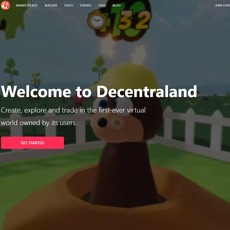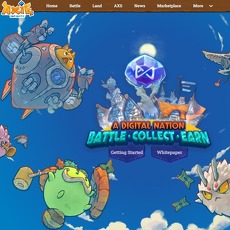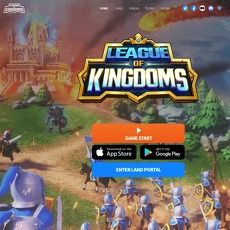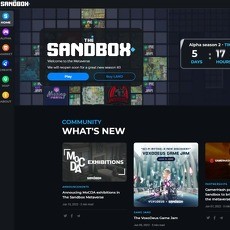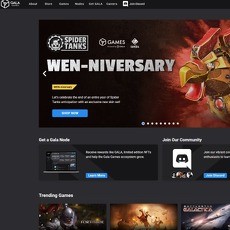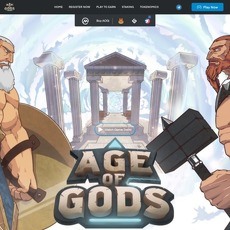Best Play-to-Earn Blockchain Games and Decentralized Games NFTs
The average gamer must have, at one point or another, encountered or heard of crypto gaming and the possibilities it unlocks thanks to blockchain integrations. The whole idea that birthed this class of games revolves around the fundamentals of decentralization and how the players can play games not only for the fun of it but also for the potential earnings that can be generated. What this means is that crypto games often run an economy that not only caters to game developers but also ensures that players get a fair share of the gaming revenue. This is unlike anything we have ever experienced in the gaming industry which is why it is important to carefully explore the workings of this innovative system.
More importantly, those interested in joining the decentralized gaming bandwagon must first find the best and safest avenue to get started with blockchain-based games. To do this, you ought to know how to identify the best decentralized games out there and how to safely navigate them. In this guide, we will introduce you to the concept of decentralized gaming, why it is a game-changer and how you can capitalize on its emergence. In addition, we will be taking a look at the factors you need to consider before opting for a decentralized game. But first, let us walk you through some of the intricacies of blockchain technology.
What is blockchain technology?
Blockchain is a technology that distributes the database of a network such that no single entity has complete control over how data is managed and stored. Think of it as a database spread across a network of computers. With this system in place, every participant can independently confirm that the content of the database is immutable and verifiable. Simply put, blockchain technology allows each node of a network to manage a copy of the database. This makes it a lot harder to have a single point of failure as it eliminates the need for relying on a centralized server.
Since participants collectively manage the database, blockchains utilize consensus mechanisms to optimize the validation process of content and transactions. Remember that the distributed databases that anchor blockchain networks are immutable. Therefore, it is critical to implement a system that ensures that the data added to the blockchain are valid. More so, the system must enable a collaborative ecosystem where network participants can jointly validate data. In most cases, this mechanism randomly picks validators at each instance and allocates tasks to them.
Notably, validators receive freshly minted cryptocurrencies as rewards for their contributions. These rewards are usually paid in the native cryptocurrency of the blockchain in question. As such, among other things, cryptocurrencies, especially those native to a specific blockchain, are usually designed as the reward system that anchors consensus mechanisms. By giving out incentives, the system motivates validators to keep dedicating their time, skill, and computer resources to the security of the blockchain.
For instance, the bitcoin network uses a computer-intensive consensus protocol called proof-of-work (PoW) mechanism and rewards validators (known as miners in the bitcoin ecosystem) with newly minted bitcoins. In the case of Ethereum, the consensus mechanism at play is also PoW. However, it is worth mentioning that Ethereum is undergoing a revamp that will see its system transition to the less energy-consuming Proof-of-Stake (PoS) protocol. The Pos model initiates a staking-based economy as validators are randomly picked among a pool of nodes that are financially invested in the well-being of the network. For their troubles, validators receive rewards denominated in Ether.
In addition to the energy-efficient nature of PoS, it also offers a much more flexible and robust blockchain ecosystem. PoS supports blockchain scaling solutions like sharding, which allows a blockchain to delegate some of its transaction validation responsibilities to sidechains. This system is particularly ideal for application-based blockchains. You might be wondering: what is an application-based blockchain and how is it different from the standard blockchain network?
Note that Bitcoin, which was the first of its kind, was built for a specific purpose. The network is designed to facilitate transactions. In its early years, the main goal was to power a digital alternative to fiat currencies. However, over the years, it became clear that the underlying technology powering bitcoin could initiate more applications. Notably, the launch of Ethereum ushered in a new phase of blockchain development trends whereby more emphasis was placed on the use of blockchain technology to tackle a plethora of problems.
During this era, developers focused on creating blockchain networks that can host thousands of applications designed to eliminate the need for middlemen during service delivery. So whether it is a trading application, an electricity distribution system, a healthcare service, you name it, chances are that the blockchain can optimize the service such that the users can do away with unnecessary fees and time-consuming processes.
In essence, the primary goal of blockchains like Ethereum is to host decentralized applications and supply all the resources they require to keep running. Thanks to the emergence of these blockchains, a lot more developers are willing to explore the potential of blockchain technology and how it can be used to improve our daily lives. Those familiar with this blockchain revolution would agree that the appeal of decentralized applications (dapps) hinges on the propensity of the average users to actively contribute to the running of a system and in turn be compensated for their contributions. All in all, blockchain promotes a community-focused model for delivering services and managing apps.
The rise of NFTs
It is impossible to discuss the growing importance of decentralized games without talking about the role that non-fungible tokens are playing. In this section, we will dissect the emergence of NFT and how it has impacted the decentralized gaming space.
What is NFT?
Non-fungible token (NFT) is a token protocol that establishes the individualism of digital assets. Before the advent of NFTs, it was a tad difficult to assign unique traits to digital assets and ensure that they are differentiable. Notably, this framework is different from the traditional crypto model that relies on fungibility to meet the requirements for functioning as a digital currency. For example, bitcoin is a fungible token because 1 BTC held by Individual A will always be equal to the 1 BTC held by Individual B. This is the same way that a 1 dollar bill can be exchanged for another 1 dollar bill, and both parties involved would not generate a profit nor incur a loss.
When it comes to fungible assets, the goal is to establish a uniform value and trait whereas non-fungibility looks to create a unique attribute that will allow us to distinguish between two or more assets, even when they look identical physically. As such, non-fungible tokens are digital assets that preserve the uniqueness and rareness of items.
NFTs are tokens that come with metadata that tells us the details about the digital asset or real-world asset they represent. For instance, if you create an NFT, you have to enter descriptions that will help establish the uniqueness of the token. The good thing about this is that NFTs exist on the blockchain. Therefore, the metadata is immutable. In other words, no one, not even the person that created it, can alter the metadata of each NFT once they go live on the blockchain. It goes without saying that this system leaves no room for fraud.
Why are NFTs considered game-changers?
From our explanation above, it is clear that NFTs implement distinguishable traits that define the value of each token. And so, it is less likely that two NFTs, even though they are identical, will command similar value in the open market. Another factor that is driving the growth of the NFT sector is the possibility of preserving the rareness of digital assets. In the real world, some assets derive their value simply because they are one of a kind. Regardless of how frequently they are duplicated, the original item will always fetch a significantly high fee. A prime example of such items are rare baseball cards.
Before the advent of NFTs, it was difficult to replicate the same level of rareness in the digital world since it was impossible to establish a trustless method of verifying the rareness of digital items. Following the introduction of NFTs, it became possible to establish the rarity of digital assets via blockchain’s verifiable and tamperproof database. By just looking up the information of an NFT on the blockchain, you can easily tell when the item was created and how many of its kind were minted.
Lastly, NFTs establish the ownership of virtual items. Just as the ownership of crypto is automatically transferred to the receiver when the transaction has been validated on the blockchain, so also do buyers become the true owners of NFTs when the evidence of the purchase has been entered into the blockchain. In essence, NFTs to an extent, eliminate the occurrence of fraud. On the blockchain, it is impossible to claim or sell items that are not linked to your private keys.
All these elements make NFTs the perfect way of representing real-world assets and digital assets on the blockchain since their uniqueness and authenticity can be verified on transparent, verifiable, and immutable databases.
What are the use cases of NFTs?
Ever since the ERC721 protocol that anchors the NFT design on Ethereum was launched in 2017, we have witnessed a sharp rise in blockchain applications looking to utilize the technology in one way or another. One of the popular NFT applications is digital art. Artists are increasingly incorporating NFTs, not only to establish the authenticity of their creation but also to eliminate the bureaucracy involved in selling and buying digital arts. Unlike what we have in the traditional art space, the NFT art market allows digital artists to sell directly to collectors and, in the process, earn a large chunk of the revenue generated.
Apart from digital arts, NFTs have also become an integral factor propelling the popularity of digital collectibles. Collectors and the average individual are increasingly favoring collectibles that incorporate NFT to confirm the authenticity and rarity of digital collections. This is why it is no surprise that even top brands like Nike, Cocacola, and the NBA have launched NFT-based collectibles or products.
Another sector that has felt the impact of NFTs is the gaming world. Much of the hype centers around the dynamism that NFT offers gamers. Unlike what we have in the traditional gaming world, NFT games enable a player-focused revenue and in-game asset system. Similar to what we have seen in other NFT-powered applications, NFT games generally transfer the ownership of in-game items to players when they earn them or purchase them on the game market. This makes it possible to transfer in-game items and ultimately monetize them. As such, it is no surprise that blockchain-based games suddenly became viable after the ERC721 protocol was introduced in the Ethereum ecosystem.
Now that we have described the popular applications of NFTs, in the next section we will be focusing on decentralized games and why they are currently one of the major talking points not only in the crypto world but also in the gaming world.
What are decentralized games?
From its name, it is clear that decentralized games have borrowed some of the functionalities of blockchain technology to enable a gaming ecosystem where players jointly manage the resources and infrastructure of the game. In simpler terms, a decentralized game incorporates blockchain technology to ensure that players are the major stakeholders of the entire gaming ecosystem, including its in-game economy. This is unlike what we have in the traditional gaming world where the in-game items and assets are confined to their respective games.
Under this restrictive model, game developers retain full control over in-game items such that players can not sell, take out, or transfer winnings or purchased items. More so, the developer has the final say regarding the future of the game. It is safe to say that these restrictions can be linked to the use of centralized servers which concentrate power to a single entity.
In contrast, decentralized gaming ensures that each player owns a share of the game. Here, when you purchase or earn in-game items like skins, avatars, weapons, and so on, you get to own them outrightly. Not only that, since you outrightly own these digital assets, you can decide to sell them for real money. In essence, you do not need to forfeit or lose your in-game items when you stop playing the game. You can simply put them up for sale on the game’s marketplace or any other NFT trading platform that supports that particular digital asset.
Likewise, decentralized gaming makes it a tad difficult for developers to manipulate the outcome of games since the codes are usually verifiable. Lastly, decentralized gaming unlocks the opportunity for players to actively participate in governance-related tasks. What this means is that players are often the decision-makers in the decentralized gaming world. Blockchain games utilize a consensus system whereby individual players get to vote on policy updates and development-based changes in general.
Types of blockchain games
There are different ways we can classify decentralized games. They include:
The degree of decentralization
Notably, blockchain games come with a varying degree of decentralization. And so, one of the ways we can classify blockchain games is to gauge the degree of decentralization they provide. Based on this classification, here are the types of decentralized games you will encounter:
Hybrid blockchain game
As its name implies, a hybrid blockchain game combines traditional gaming and blockchain implementations. For instance, several blockchain games have opted to retain a centralized infrastructure for their games but introduced an NFT-powered economy such that all of the in-game assets exist on the blockchain. In other words, they still run a centralized game only to initiate a means of minting in-game assets on the blockchain. So, while the game itself is centralized, the economy is decentralized since players can acquire and sell in-game assets as they wish. An example of a blockchain game that falls under this category is Gods Unchained.
Fully decentralized games
In contrast to the hybrid system described above, some blockchain games fully embrace the concept of decentralization. Not only do they decentralize the gaming economy, but they also host the game on a decentralized infrastructure. In essence, they are blockchain gaming applications with an open infrastructure. So, the game itself and the outcome of the gameplays can be verified. In addition to this, such games utilize a decentralized governance mechanism. With this, token holders can vote on core issues, including key infrastructural changes.
The financial requirements for new players
We can also classify decentralized games based on the presence or absence of financial requirements for new players. Based on this classification, there are two types of decentralized games. They are:
Free-to-play decentralized games
Free-to-play games are games that do not require players to invest an initial capital. These platforms do not impose any financial requirement whatsoever on new players before they are allowed to start playing. In essence, all you need to do is register or complete some tasks to start enjoying the game. For such games, the entry barrier is low. However, this does not mean that you will not at some point need to purchase in-game items to boost your chances of winning.
Pay-to-earn decentralized games
In contrast to the game model described above, pay-to-earn decentralized games are set up in such a way that new players have to buy in-game assets to become eligible to play the game. Depending on the game in question, the pay-to-earn model was designed with the expectation that players have to invest an initial capital before they start playing against either the computer or other players. A prime example of games that run a pay-to-earn model is Axie Infinity. To start playing Axie Infinity, new players have to purchase three NFT-based mythical creatures called Axies. New Axie Infinity players have been reported to invest as high as $1,000 to purchase their first three Axies. Owing to the high entering barrier of Axie Infinity, players sometimes depend on scholarships which can be likened to an Axie lending deal that requires players to manage Axies on behalf of Axie holders to receive a share of the winnings.
The game theme
Another way we can classify decentralized games is to consider the underlying theme of the game. The factors that can help identify the game theme include the gameplay, the story arc of the game, and the way the game’s digital world has been designed. Bearing these factors in mind, below are the four major types of decentralized games based on gaming themes.
Collectible games
As its name implies, a collectible game requires players to collect digital animals or creatures with the sole aim of breeding new ones and selling them on the marketplace. Depending on the specifics of the game in question, emphasis is placed on the traits of each digital creature as well as their rarity type. The rarer the trait or creature is, the higher the price it will command on the marketplace. An example of a collectible-based game is CryptoKitties.
Role-playing games (RPG)
In these games, you need to play a particular character while going up against different game elements and other in-game characters which may be controlled by other players. Some of the games that fall under this category are shooting games. At the time of writing, only a few decentralized games offer an RPG-based theme.
Open world games
These games are explorable digital worlds optimized by crypto in-game assets. The goal is to create a metaverse where players can explore with their NFT-based avatars. For example, Decentraland offers an ever-expanding digital world filled with scenes and sights designed to keep players coming for more. The good thing about these games is that they allow users to contribute to the overall expansion and growth of the metaverse. In these games, users can access building tools. More importantly, players have full control over their creations, which makes it a lot easier to monetize them.
Card games
More often than not, card games are designed in such a way that players collect NFT cards for the sole aim of participating in strategy-based card battles. Here, players take turns to initiate a series of attacking moves against other players. One of such games that has a card-battling theme is Gods Unchained.
Now that we have explored the various classifications of decentralized games, let us take a look at how you can start playing them.
How to play decentralized games
The first thing that you should have at the back of your mind is that you will most likely need to create a wallet before you can start playing blockchain-based games. As such, we advise that you search for a quality wallet service provider that works seamlessly with decentralized applications. Since most of the popular games run on Ethereum’s blockchain, ensure that the wallet you eventually opt for supports the Ethereum ecosystem.
Secondly, ensure that you have the native cryptocurrencies of the blockchains on which the game exists. This is because you will most likely need to pay fees with them. You can purchase these cryptocurrencies on popular crypto exchanges like Binance and Coinbase. You can check our crypto exchange guide for a list of other exchanges that provide quality services. While at it, ensure that you do not compromise when it comes to the safety of your digital assets.
Once you set up a wallet and load it with coins, the next thing you need to do is to pick from the growing list of games offering blockchain-powered features.
Factors to consider when choosing a decentralized game
Before choosing a game, there are several factors that you should consider. In this section, we will highlight some of them starting with the game theme you are looking to explore.
The type of game theme
As mentioned earlier in this guide, there are a wide variety of game themes that you can explore in the decentralized gaming ecosystem. You can streamline your search for a quality decentralized game by focusing on a particular theme. Here, you need to ask yourself: Is card-battling your forte, or would you rather prefer to explore virtual worlds powered by NFTs? At the end of the day, there is a high chance that you will easily understand games with themes that you are familiar with.
The decentralization status of the game
Once you have chosen a specific theme, the next step is to consider the decentralization framework at play. Here, you need to decide whether you want to settle for a hybrid game or opt for a fully decentralized game. Note that the degree of decentralization would go a long way to determine whether you will be able to access certain features. For instance, hybrid games have a higher tendency of offering traditional payment systems that allow players to buy NFT-based in-game assets with fiat currencies. On the other hand, fully decentralized games are more likely to implement a community-focused governance model to give the average user a chance of receiving voting rights.
Another advantage of fully decentralized games over hybrid ones is that they are open source. Therefore, it is possible to confirm that no one, not even the developer, has the power to manipulate the game. On the other hand, hybrid games almost always inherit the advanced game graphics associated with traditional games.
The reputation of the developer
As always, we advise that you conduct a check on the reputation of the developer of the game you are intending to adopt. One of the factors that you should consider here is the experience of the core members of the development team both in the blockchain and gaming industry. It will be advisable to opt for games provided by reputable developers.
The underlying blockchain of the game
When on the verge of choosing a decentralized game, make sure that you consider how the underlying blockchains could impact the viability of the games. For instance, Ethereum seems to be a popular choice among developers because it is already an established blockchain ecosystem that attracts a significantly high volume of activities. In other words, when you opt for an Ethereum-based game, your chances of matching instantly with other players or finding a buyer for in-game assets are higher. But then, Ethereum is not reliable when it comes to scalability. So, although Ethereum-based games might be more competitive, they may not offer the smooth gaming experience that games on other application-based blockchains provide.
The possibility of playing it for free
Understandably, free-to-play blockchain games are the ideal options for players new to decentralized gaming. If you believe this to be true, then your focus should be on choosing a quality blockchain-based game with a low entry barrier. For those who are not deterred by the initial financial requirements of pay-to-earn games, it is critical to determine the capital you need to start with and gauge your chances of recouping your investment.
How did Cryptolinks curate the list of top decentralized games
To make sure you have productive research, we have compiled the list of top blockchain-based games as well as detailed information about their operations. With this, you can access all of the information and data you need in a single place. However, you may be wondering: How did we arrive at our list?
Well, we followed our advice by basing our research on the factors listed in this guide. And so, we identified the theme of each decentralized game on our list and carried out a comparative analysis showing how they fare against other decentralized games with similar themes. Next, we took a look at the decentralization status of each game and how it affects their performance. Reputation was also a deciding factor. We then considered the blockchain infrastructure powering the platforms and their effects on the overall performance of the games and their in-game economies. Lastly, we analyzed how the presence or absence of initial capital requirements affect the appeal of the game.
At the end of it all, we came up with a list of quality decentralized games that you should consider. You can access a detailed review of each game by clicking the name.

